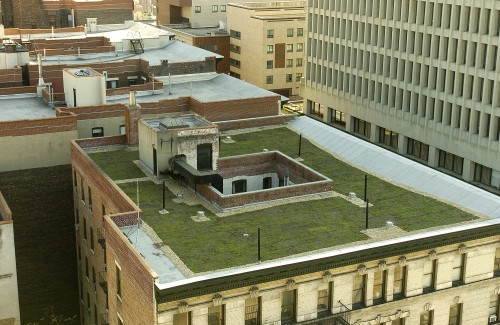What’s Next to Go Green? Columbia’s Roofs

In a city where most roofs are barren, tar-topped eyesores, two Columbia University-owned buildings feature lush vegetation on their rooftops that pleases the eye and fulfills the University's promise to lower its carbon emissions.
In early November, Columbia University Facilities installed "green roofs" at 423 West 118th Street (above Radio Perfecto) and 635 West 115th Street, where the Office of Environmental Stewardship is located.
"Green roofs will help sustain not only the buildings where our students, faculty and staff work, but also the community in which we live," said Joe Ienuso, Executive Vice President for Columbia University Facilities. "The benefits that green roofs deliver to the environment - including cleaner air quality and energy conservation - relate to us all."
Most roofs, especially the blacktop asphalt covered kind, absorb and radiate heat, warming up both the roof's surface and the city around it. Grass and plants growing on green roofs take in carbon dioxide from the atmosphere and turn it into oxygen, helping cool temperatures in the hottest months and cleaning the air supply.
"By replacing heat absorbing tar and other dark roofing materials with plants, green roofs can substantially reduce what is known as the "urban heat island" effect - the trend for cities to be warmer than the surrounding suburbs," said Nilda Mesa, Director of Environmental Stewardship.
Green roofs also insulate buildings, reducing oil use during the winter. Structurally, green roofs can increase the lifespan of a roof by an estimated 100%.
This project also integrates interdisciplinary expertise on green roofs. Leading climate scientists, Cynthia Rosenzweig, a researcher at the Goddard Institute for Space Studies, and Stuart Gaffin, with the Center for Climate Systems Research, are leading an effort to establish green roof research stations in New York City to expand the understanding, and eventually, the application of green roofs in urban environments. The scientists have set up a research station at 423 West 118th Street to continuously capture data about the green roof's impact. This is the first green roof project that showcases and integrates the scientific expertise of world-renowned experts in climate and related fields of research. According to Gaffin, it is unprecedented to have the kind of scientific input integrated into a NYC green roof. "We've designed it carefully with controls and variables, carefully selected sensors to take in data."
If successful, the University anticipates greening many more roofs in the future, which supports Mayor Michael Bloomberg's vision of making the majority of New York roofs green by 2050 as part of PlaNYC.